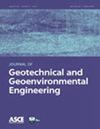A Simplified Method for Bearing-Capacity Analysis of Energy Piles Integrating Temperature-Dependent Model of Soil–Water Characteristic Curve
IF 3.9
2区 工程技术
Q1 ENGINEERING, GEOLOGICAL
Journal of Geotechnical and Geoenvironmental Engineering
Pub Date : 2023-09-01
DOI:10.1061/jggefk.gteng-11095
引用次数: 3
Abstract
32 The bearing resistance of energy piles in the presence of temperature effect has not been thoroughly 33 investigated, preventing the perfecting of energy pile design methods. Quantifying the relationship between soil 34 suction and the temperature of unsaturated soils therefore becomes an important step in predicting the bearing 35 resistance of energy piles. A new constitutive model based on interfacial energy and thermodynamic theories is 36 therefore presented to predict the effect of temperature on soil suction as well as the soil-water characteristic 37 curve (SWCC) in this paper. The analytical model for the nonisothermal matric suction was developed by 38 combining five different temperature-dependent functions for the surface tension, air-water contact angle, void 39 ratio, and thermal expansion of solid and water density, thereby providing a more complete approach than the 40 one that considers surface tension only. The proposed formulation is expressed under a simplified form which is 41 believed as a useful and convenient tool to apply to a range of possible field situations. The temperature-42 dependent relationship of soil suction is then used to extend existing isothermal SWCCs to nonisothermal 43 conditions that allow obtaining the SWCC at any temperature. The validity of the proposed model is verified by 44 comparison to several test data sets for five different soils: swelling clay, hard clay, clayey-silty soil, ceramic 45 material, and sand. The satisfactory agreement between predicted and measured curves proved that the proposed 46 model has a good performance in predicting the effect of temperature on the SWCCs of unsaturated soils. The 47 nonisothermal SWCC model was then coupled with the bearing resistance theory to produce a simplified method 48 for analysis of energy piles. The results show that the proposed method successfully predicted pile resistance at 49 various temperatures when compared to experimental data. The pile resistance reduces as the temperature rises 50 for a specific degree of saturation or if the soil is in an undrained condition. However, water evaporation may 51 cause a decrease in water content and an increase in matric suction as the temperature increases. Therefore, as 52 soils dry out, pile resistance may increase with increasing temperature.结合温度-水特性曲线模型的能量桩承载力简化分析方法
32在存在温度效应的情况下,能量桩的承载力尚未得到彻底研究33,阻碍了能量桩设计方法的完善。因此,量化土壤吸力与非饱和土壤温度之间的关系成为预测能量桩承载力35阻力的重要步骤。因此,本文提出了一个基于界面能和热力学理论的新的本构模型,以预测温度对土壤吸力的影响以及土壤水分特性曲线(SWCC)。非等温基质吸力的分析模型是由38结合表面张力、空气-水接触角、空隙率以及固体和水密度的热膨胀的五个不同的温度相关函数开发的,从而提供了比仅考虑表面张力的40更完整的方法。所提出的公式以简化的形式表示,41被认为是适用于一系列可能的现场情况的有用和方便的工具。然后,土壤吸力的温度-42依赖关系用于将现有的等温SWCC扩展到允许在任何温度下获得SWCC的非等温43条件。44通过与五种不同土壤的几个测试数据集的比较,验证了所提出模型的有效性:膨胀粘土、硬粘土、粘性粉土、陶瓷45材料和沙子。预测曲线与实测曲线之间的一致性令人满意,证明所提出的46模型在预测温度对非饱和土SWCC的影响方面具有良好的性能。然后将47非等温SWCC模型与承载阻力理论相结合,以产生用于分析能量桩的简化方法48。结果表明,与实验数据相比,该方法成功地预测了49种不同温度下的桩阻力。对于特定的饱和度,或者如果土壤处于不排水状态,则桩阻力随着温度升高50而减小。然而,随着温度的升高,水的蒸发51可能导致水含量的降低和基质吸力的增加。因此,随着52种土壤的干燥,桩阻力可能会随着温度的升高而增加。
本文章由计算机程序翻译,如有差异,请以英文原文为准。
求助全文
约1分钟内获得全文
求助全文
来源期刊
CiteScore
7.50
自引率
7.70%
发文量
222
审稿时长
12 months
期刊介绍:
The Journal of Geotechnical and Geoenvironmental Engineering covers the broad area of practice known as geotechnical engineering. Papers are welcomed on topics such as foundations, retaining structures, soil dynamics, engineering behavior of soil and rock, site characterization, slope stability, dams, rock engineering, earthquake engineering, environmental geotechnics, geosynthetics, computer modeling, groundwater monitoring and restoration, and coastal and geotechnical ocean engineering. Authors are also encouraged to submit papers on new and emerging topics within the general discipline of geotechnical engineering. Theoretical papers are welcomed, but there should be a clear and significant potential for practical application of the theory. Practice-oriented papers and case studies are particularly welcomed and encouraged.

 求助内容:
求助内容: 应助结果提醒方式:
应助结果提醒方式:


